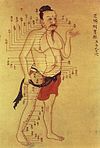Feng shui


| Feng shui | |||||||||||||||||||||||||||||||||||||
|---|---|---|---|---|---|---|---|---|---|---|---|---|---|---|---|---|---|---|---|---|---|---|---|---|---|---|---|---|---|---|---|---|---|---|---|---|---|
| Nome chinês | |||||||||||||||||||||||||||||||||||||
| Chinês tradicional: | 風水 | ||||||||||||||||||||||||||||||||||||
| Chinês simplificado: | 风水 | ||||||||||||||||||||||||||||||||||||
| Significado literal | "wind-water" | ||||||||||||||||||||||||||||||||||||
| |||||||||||||||||||||||||||||||||||||
| Em filipino | |||||||||||||||||||||||||||||||||||||
| Tagalo: | Pungsóy, Punsóy | ||||||||||||||||||||||||||||||||||||
| Em japonês | |||||||||||||||||||||||||||||||||||||
| Kanji: | 風水 | ||||||||||||||||||||||||||||||||||||
| Hiragana: | ふうすい | ||||||||||||||||||||||||||||||||||||
| |||||||||||||||||||||||||||||||||||||
| Em coreano | |||||||||||||||||||||||||||||||||||||
| Hangul: | 풍수 | ||||||||||||||||||||||||||||||||||||
| Hanja: | 風水 | ||||||||||||||||||||||||||||||||||||
| |||||||||||||||||||||||||||||||||||||
| Em tailandês | |||||||||||||||||||||||||||||||||||||
| Tailandês: | ฮวงจุ้ย (Huang chui) | ||||||||||||||||||||||||||||||||||||
| Em vietnamita | |||||||||||||||||||||||||||||||||||||
| Vietnamita: | phong thủy | ||||||||||||||||||||||||||||||||||||
O feng shui (em chinês: 風水), também conhecido como geomancia chinesa, é uma prática pseudocientífica originária da China antiga.[1][2][3]
Alega usar forças energéticas para harmonizar os indivíduos com o ambiente ao seu redor. O termo feng shui se traduz literalmente como "vento-água". Esta é uma apropriação cultural retirada do agora perdido Livro do Enterro [en] registrado nos comentários de Guo Pu [en].[4][5]
O Feng Shui é uma das Cinco Artes da Metafísica Chinesa, classificada como fisiognomia (observação das aparências através de fórmulas e cálculos). A prática do feng shui discute a arquitetura em termos de "forças invisíveis" que unem o universo, a terra e a humanidade, conhecidas como qi.[6]
Historicamente o feng shui era amplamente utilizado para orientar edifícios - geralmente estruturas espiritualmente significativas, como túmulos, mas também residências e outras estruturas. Dependendo do estilo particular de feng shui que está sendo usado, um local auspicioso pode ser determinado em relação a características locais como corpos d'água, estrelas ou através do uso de uma bússola.[7][8][5]
Ver também
[editar | editar código-fonte]Referências
- ↑ Vyse, Stuart (2020). «Superstition and Real Estate». Skeptical Inquirer. 44 (3): 26–28
- ↑ Matthews, Michael R. (2018). «Feng Shui: Educational Responsibilities and Opportunities». In: Matthews, Michael R. History, Philosophy and Science Teaching: New Perspectives. Col: Science: Philosophy, History and Education. Cham, Switzerland: Springer. 31 páginas. ISBN 978-3-319-62616-1
- ↑ Matthews, Michael R. (2019). Feng shui: teaching about science and pseudoscience. Cham, Switzerland: Springer. ISBN 978-3-030-18822-1. OCLC 1109957069
- ↑ «The Zangshu, or Book of Burial, translated by Stephen L Field, Phd.». Professor Field's Fengshui Gate. Consultado em 31 de julho de 2020. Cópia arquivada em 21 de maio de 2020
- ↑ a b Magli, Giulio (2020). Sacred Landscapes of Imperial China: Astronomy, Feng Shui, and the Mandate of Heaven. [S.l.]: Springer Nature. ISBN 978-3-030-49324-0
- ↑ «Feng Shui». Institute of Feng Shui. Consultado em 15 de maio de 2011. Arquivado do original em 13 de julho de 2011
- ↑ Carroll, Robert T. «feng shui». The Skeptic's Dictionary. Consultado em 14 de maio de 2012
- ↑ Wallace H. Campbell. Earth Magnetism: A Guided Tour Through Magnetic Fields. Academic Press, 2001. p. 2 "Written records show that a Chinese compass, Si Nan, had already been fabricated between 300 and 200 BE and used for the alignment of constructions to be magically harmonious with the natural Earth forces.
Bibliografia
[editar | editar código-fonte]- Liu, Li (2004). The Chinese Neolithic: Trajectories to Early States. [S.l.]: Cambridge University Press. ISBN 9780521811842
- Wang, Aihe (2000). Cosmology and Political Culture in Early China. [S.l.]: Cambridge University Press. ISBN 9780521027496
- Emmons, C. F. (1992). «Hong Kong's Feng Shui: Popular Magic in a Modern Urban Setting». Journal of Popular Culture. 26 (1): 39–50. doi:10.1111/j.0022-3840.1992.00039.x
- Swetz, Frank J. (2002). The Legacy of the Luoshu: the 4,000 year search for the meaning of the magic square of order three. [S.l.: s.n.] ISBN 9780812694482
- Cheng, Jian Jun; Fernandes-Gonçalves, Adriana (1998). Chinese Feng Shui Compass: Step by Step Guide. [S.l.: s.n.]
- Nelson, Sarah M.; Matson, Rachel A.; Roberts, Rachel M.; Rock, Chris; Stencel, Robert E. (2006). «Archaeoastronomical Evidence for Wuism at the Hongshan Site of Niuheliang». Cópia arquivada em 23 de setembro de 2006
Leituras complementares
[editar | editar código-fonte]- Ernest John Eitel (1878). Feng-shui: or, The rudiments of natural science in China. Hongkong: Lane, Crawford. Consultado em 6 de julho de 2011
- Koch, Aaron Lee (2014). Feng Shui Q&A. [S.l.]: 8 Feng Shui Publishing. ISBN 978-1-312-61845-9
- Bruun, Ole (1995). «Fengshui and the Chinese Perception of Nature». In: Bruun, Ole; Kalland, Arne. Asian Perceptions of Nature: A Critical Approach. Surrey: Curzon. pp. 173–88
- Bruun, Ole (2008). An Introduction to Feng Shui. [S.l.]: Cambridge University Press
- Bruun, Ole (2003). Fengshui in China: Geomantic Divination between State Orthodoxy and Popular Religion. Honolulu: University of Hawai'i Press. ISBN 9788791114793
- Yoon, Hong-key (2006). Culture of Fengshui in Korea: An Exploration of East Asian Geomancy. [S.l.]: Lexington Books
- Xie, Shan Shan (2008). Chinese Geographic Feng Shui Theories and Practices. [S.l.]: National Multi-Attribute Institute Publishing. ISBN 978-1-59261-004-4
- Charvatova, I.; Klokocnik, J.; Kolmas, J.; Kostelecky, J. (2011). «Chinese tombs oriented by a compass: Evidence from paleomagnetic changes versus the age of tombs». Studia Geophysica et Geodaetica. 55 (1): 159–74. doi:10.1007/s11200-011-0009-2
- Chen, X.; Wu, J. (2009). «Sustainable landscape architecture: Implications of the Chinese philosophy of 'unity of man with nature' and beyond». Landscape Ecology. 24 (8): 1015–26. doi:10.1007/s10980-009-9350-z
- Lacroix, R.; Stamatiou, E. (2006). «Feng shui and spatial planning for a better quality of life». WSEAS Transactions on Environment and Development. 2 (5): 578–83. Retrieved from http://search.proquest.com/docview/290374661
- Kereszturi, A.; Sik, A. (2000). «Feng-shui on Mars – History of geomorphological effects of water and wind» (PDF). Abstracts of Papers Submitted to the Lunar and Planetary Science Conference. 31. abstr. no. 1216

